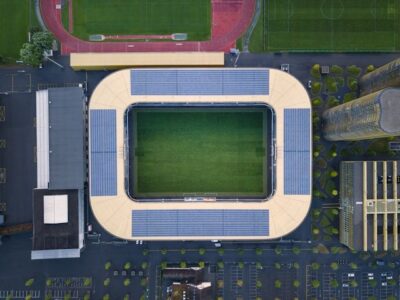Sports venues aren’t what they used to be. They’re no longer just big shells of concrete packed with plastic seats and concession stands on every corner. Today’s venues are living, breathing ecosystems—wired with sensors, powered by algorithms, and designed with data in mind. And here’s the kicker: the same kind of structured analysis used in something as traditional as Muay Thai scoring (https://www.thsport.live/scoremuay-thai.html) is now influencing how architects, engineers, and event planners think about the spaces where thousands of people gather.
It might sound strange at first—comparing the scoring of a martial arts bout to the planning of a billion-dollar stadium—but both rely on the same principle: measure what matters, and design around it.
Numbers Behind the Noise
When most people hear the phrase sports analytics, their minds jump to player stats, win probabilities, or fantasy leagues. But behind the curtain of venue design, analytics has an entirely different role.
Think about something as basic as sightlines. Stadium architects now use advanced modeling, supported by years of fan experience data, to ensure that no seat feels like a punishment for buying the cheap ticket. Acoustics? That’s another science in itself. Data simulations help planners predict how crowd noise will bounce around, whether it’s the roar of a touchdown or the hushed suspense of a penalty kick.
There’s even math behind how people move. Flow analytics—tracking how crowds enter, navigate, and exit—has become as important as building codes. A poorly designed concourse can turn into gridlock, which isn’t just inconvenient but dangerous. Casinos have long studied player movement to keep guests circulating, and concert halls have obsessed over sound travel for decades. Now, sports venues are fusing those lessons with fan data to create a seamless experience from parking lot to nosebleeds.
Lessons from Combat Sports
Here’s where the Muay Thai comparison comes back into play. In Muay Thai, judges award points not just for brute strength but for precision, timing, and effectiveness. A sloppy flurry might look exciting, but it won’t rack up the same score as a clean, well-placed strike. Venue design works on a similar principle.
A flashy feature—say, a 360-degree LED ribbon or a retractable roof—might grab headlines. But what actually earns “points” in the long run is how well the venue functions: clear sightlines, efficient crowd flow, reliable tech infrastructure, and sustainable systems that don’t bleed money on utilities.
It may feel odd to put a fight-scoring framework next to an architectural blueprint, but the parallel makes sense. Both are about evaluation rooted in structure. Both are about fairness and predictability. And, ultimately, both are about delivering an experience that feels balanced and satisfying.
The Fan Experience as Data Gold
If you’ve ever stood in a bathroom line that seemed longer than halftime itself, you already know this: fan comfort is now a measurable data point.
Modern stadiums and arenas rely heavily on digital tracking. Ticket scans tell planners how fans arrive, mobile apps reveal food and drink orders, Wi-Fi usage shows where crowds linger, and wearable devices can even track real-time heart rates during a nail-biter finish.
These aren’t just curiosities. They’re signals. If Wi-Fi demand spikes in one section, planners might boost router capacity there. If certain concessions outsell others, layouts can be reworked to match demand. Baseball was one of the first sports to really lean on this kind of fan tracking—teams like the Oakland A’s used data to reconfigure everything from ticket pricing to stadium flow. Now, every sport is catching up, and it’s bleeding into how venues themselves are constructed from the ground up.

Sustainability Meets Smart Design
Here’s the thing: it’s not only about fans. Energy bills and maintenance costs are enormous for a venue that might hold 70,000 people. That’s where analytics step in again.
Smart HVAC systems adjust airflow based on occupancy levels, while predictive models anticipate energy demand before the doors even open. Lighting systems respond to natural daylight, cutting unnecessary costs. Sensors track equipment wear-and-tear, flagging issues before they spiral into million-dollar repairs.
Some venues go further, earning LEED certifications by embedding sustainability into the blueprint. Think rainwater capture, green roofs, and solar arrays—all planned with predictive efficiency models. Because let’s be honest: nobody wants to be freezing in July or sweating in December just because the system didn’t account for actual conditions.
Balancing the Human Factor
Of course, data can’t account for everything. There’s still something intangible about being in a crowd, shoulder to shoulder with strangers, when your team pulls off an impossible comeback. That swell of emotion—the goosebumps, the guttural roar—that isn’t in any spreadsheet.
Venue designers have to respect that. Analytics can optimize crowd flow, sound, lighting, and comfort, but it can’t script passion. It’s like architecture in general: you can draw the most precise blueprint, but the feeling of walking into a building—the warmth, the presence, the “something”—that’s harder to pin down.
Some designers even say the best venues leave room for a little unpredictability. Not chaos, but surprise. Think of the way Madison Square Garden has a vibe that no amount of modeling could fully predict. Or how Wrigley Field feels alive in ways newer stadiums try but can’t quite replicate.
A Peek Into the Future
So, where does this all lead? If current trends are any clue, venues are only going to get smarter.
Artificial intelligence is being tested for predictive crowd management—anticipating choke points before they happen and rerouting fans with subtle nudges like signage or app notifications. Hybrid spaces are rising too, designed to flip overnight from an NBA court to an esports arena to a mega-concert.
There’s even a cultural shift to consider. TikTok moments, viral fan reactions, and the need for broadcast-friendly angles are influencing camera placement and in-stadium screen design. A stadium is no longer just a place to watch; it’s a stage for both professional athletes and the fans themselves.
Wrapping It Up
Analytics have made their way into almost every corner of modern life, and stadiums are no exception. From the scoring systems of traditional combat sports to the Wi-Fi routers tucked behind arena walls, the common thread is clear: measure carefully, design smarter, and keep the human experience front and center.
Because at the end of the day, a venue isn’t just numbers on a dashboard. It’s where memories happen. It’s where fans remember the first time they saw their team win, or where a concert brought strangers together in one thunderous chorus.
For architects, investors, and planners, the message is simple: analytics aren’t a crutch. They’re a compass. Used well, they point us toward venues that aren’t just efficient or profitable, but unforgettable.












